Into the Abyss
Humankind holds a fascination with the ocean beneath its surface. People began their study of the sea by peering into the waters from vessels or by walking along the seashore. They progressed to free diving, then helmet diving, and finally to the use of SCUBA, and ultimately to undersea vehicles, all to catch a glimpse of life under the sea.
From Ship and Shore
1845-1 1845-2Free Diving
1926 1951-1 1951-2Helmet Diving
1928-1 1928-2 1951Self-contained Underwater Breathing Apparatus
1865 1953-1 1953-2Undersea Vehicles
1934-1 1934-2 1934-3 1934-4 1934-5 1954 1969
1845-1 (From Ship and Shore)
A Soft Fish - the Destroyer of Sharks
"One day I was amused by watching the habits of the Diodon antennatus, which was caught swimming near the shore. This fish, with its flabby skin, is well known to possess the singular power of distending itself into a nearly spherical form. After having been taken out of water for a short time, and then again immersed in it, a considerable quantity both of water and air is absorbed by the mouth, and perhaps likewise by the branchial orifices. This process is effected by two methods: the air is swallowed, and is then forced into the cavity of the body, its return being prevented by a muscular contraction which is externally visible: but the water enters in a gentle stream through the mouth, which is kept wide open and motionless; this latter action must, therefore, depend on suction. The skin about the abdomen is much looser than that on the back; hence, during the inflation, the lower surface becomes far more distended than the upper; and the fish, in consequence, floats with its back downwards. Cuvier doubts whether the Diodon in this position is able to swim; but not only can it thus move forward in a straight line, but it can turn round to either side. This latter movement is effected solely by the aid of the pectoral fins; the tail being collapsed, and not used. From the body being buoyed up with so much air, the branchial openings are out of water, but a stream drawn in by the mouth constantly flows through them."
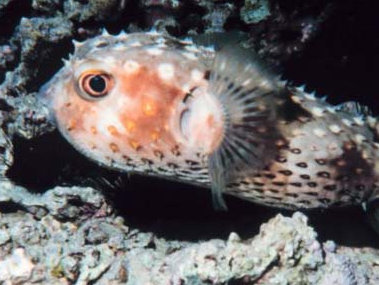
Puffer fish (Dioden sp) at rest in reef. (Courtesy of NOAA Photo Library.) Download larger version (jpg, 63 KB).
"The fish, having remained in this distended state for a short time, generally expelled the air and water with considerable force from the branchial apertures and mouth. It could emit, at will, a certain portion of the water, and it appears, therefore, probable that this fluid is taken in partly for the sake of regulating its specific gravity. This Diodon possessed several means of defense. It could give a severe bite, and could eject water from its mouth to some distance, at the same time making a curious noise by the movement of its jaws. By the inflation of its body, the papillae, with which the skin is covered, become erect and pointed. But the most curious circumstance is, that it secretes from the skin of its belly, when handled, a most beautiful carmine-red fibrous matter, which stains ivory and paper in so permanent a manner that the tint is retained with all its brightness to the present day: I am quite ignorant of the nature and use of this secretion. I have heard from Dr. Allan of Forres, that he has frequently found a Diodon, floating alive and distended, in the stomach of the shark, and that on several occasions he has known it eat its way, not only through the coats of the stomach, but through the sides of the monster, which has thus been killed. Who would ever have imagined that a little soft fish could have destroyed the great and savage shark?"
In The Voyage of the Beagle (1909) by Charles Darwin. pp. 23-24. Edited by Charles W. Eliot, Editor, The Harvard Classics, Vol. 29, 1909.
1845
The Kelp Forest (From Ship and Shore)
"The number of living creatures of all Orders, whose existence intimately depends on the kelp, is wonderful. A great volume might be written, describing the inhabitants of one of these beds of sea-weed. Almost all the leaves, excepting those that float on the surface, are so thickly incrusted with corallines as to be of a white color. We find exquisitely delicate structures, some inhabited by simple hydra-like polypi, others by more organized kinds, and beautiful compound Ascidiae. On the leaves, also, various patelliform shells, Trochi, uncovered molluscs, and some bivalves are attached. Innumerable crustacea frequent every part of the plant. On shaking the great entangled roots, a pile of small fish, shells, cuttle-fish, crabs of all orders, sea-eggs, star-fish, beautiful Holuthuriae, Planariae, and crawling nereidous animals of a multitude of forms, all fall out together. Often as I recurred to a branch of the kelp, I never failed to discover animals of new and curious structures. In Chiloe, where the kelp does not thrive very well, the numerous shells, corallines, and crustacea are absent; but there yet remain a few of the Flustraceae, and some compound Ascidiae; the latter, however, are of different species from those in Tierra del Fuego: we see here the fucus possessing a wider range than the animals which use it as an abode. I can only compare these great aquatic forests of the southern hemisphere with the terrestrial ones in the intertropical regions. Yet if in any country a forest was destroyed, I do not believe nearly so many species of animals would perish as would here, from the destruction of the kelp. Amidst the leaves of this plant numerous species of fish live, which nowhere else could find food or shelter; with their destruction the many cormorants and other fishing birds, the otters, seals, and porpoises, would soon perish also; and lastly, the Fuegian savage, the miserable lord of this miserable land, would redouble his cannibal feast, decrease in numbers, and perhaps cease to exist."
In The Voyage of the Beagle (1909) by Charles Darwin. pp. 244-245. Edited by Charles W. Eliot, Editor, The Harvard Classics, Vol. 29, 1909.
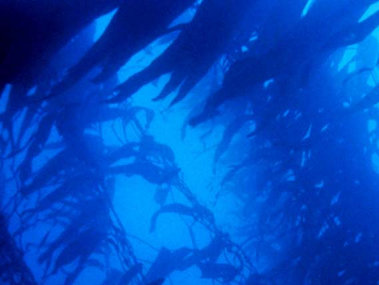
Kelp forests can grow as tall as 100 feet above the ocean floor and provide shelter for fish, snails, crabs, and sea otters. (Courtesy of NOAA Photo Library.) Download larger version (jpg, 47 KB).
1926 (Free Diving)
Diving in the Sargasso Sea
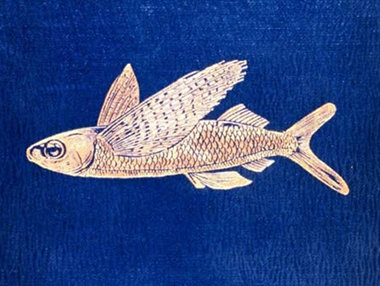
Cover to Nature Notes for Ocean Voyagers by Alfred Carpenter. NOAA Photo Library. Download larger version (jpg, 121 KB).
"I dived and entered an ultramarine world, with sprigs of amber sargassum weed floating near the ceiling of that world. Tiny fish darted past, and once, even with the dullness of my aquatic vision, I saw a small school vanish from view - a group of timid flyingfish which took to wing and entered the air at sight of my strange appearance. I dived a second time and sank as low as my stored-up breath permitted, and then before I turned and kicked upward, took one long look beneath and tried to imagine that unimaginable world of life down, down in the ever blackening, ever greater pressured depths. No ship or companion was visible and my sense of devastating isolation, of cosmic awe can never again occur with equal force in this life..."
"Here then in the midst of the sea, for a moment, I peered down toward the mid-ocean ridge which Wagner [sic, actually Wegener, the formulator of the theory of continental drift] would use to fill up a chink in his continental mosaic; which some would have as the site of old Atlantis, or others strew with the weed-caught wrecks of ancient galleys, medieval ships, and modern dreadnaughts. But no theory, whether plausible or incredible, could ever people these depths with beings stranger than those piscine elves and hobglobins which we were soon to draw up into the light and warmth of our daylight."
"I followed the last stream of my life-bubbles to the surface ..." describing a free dive in the Sargasso Sea in the middle of the Atlantic Ocean.
In The Arcturus Adventure (1926) by William Beebe. Published by G. P. Putnam's Sons, New York. pp. 36-37.
1951-1 (Free Diving)
Free Diving Versus Helmet Diving

Boutan's method of obtaining instantaneous photographs of fish. In "The Photography of Aquatic Animals in Their Natural Environment" by Jacob Reighard, (1907). Bulletin of the Bureau of Fisheries, Vol. XXVII, pp. 41-68. NOAA Photo Library. Download larger version (jpg, 28 KB).
"I liked to use my face mask more than the diving helmet for most occasions. I was learning to hold my breath longer now and could go down almost as deep without the helmet which limited my movements..."
In Lady with a Spear (1951) by Eugenie Clark. Published by Harper and Brothers, New York. pp. 51.
1951-2 (Free Diving)
An Expert Diver
"Professor Hiatt and I wore face masks and the Fisheries Director, Vernon Brock, who ordinarily wore strong glasses, had special underwater goggles with ground lenses. Mr. Brock also wore frog's feet and had a spear."
"The water was blue and incredibly clear. I swam around near the surface, looking down at the magnificent reef below. I watched Mr. Brock dive to almost forty feet while he explored the cavernous reefs among which thousands of gorgeous tropical fish were living. Then slowly, with the maneuvers of an expert underwater swimmer, Mr. Brock followed a huge green parrot fish and after a quick thrust he had it flapping on his spear as he swam back to the surface. It was a thrilling capture to watch but even though I hadn't wanted to miss a moment of it, I had been forced to lift my head out of the water briefly several times during Mr. Brock's single-breath dive. I vowed that someday I would learn to use a spear and catch fish this way in their own environment. In comparison, how dull it is to sit up in the airy world and pull a fish out of the water on a line!"
In Lady with a Spear (1951) by Eugenie Clark. Published by Harper and Brothers, New York. pp. 40-41.
1928-1 (Helmet Diving)
Knights of Old
"You are standing on a metal ladder in water up to your neck. Something round and heavy is slipped gently over your head, and a metal helmet rests upon your shoulders. Thus were the knights of old helmeted by their squires for the grim business of war. Instead of a slotted vizor, however, you find two large frames of glass before your eyes. Turning your head you see emerald waves breaking upon the distant beach of ivory, backed by feathery palms waving in the sunlight against a sky of pure azure."

Detail of "A diver in full costume making a sensational descent." Cover of "Scientific American Supplement," Vol. LXXX, Number 2077, October 23, 1915. Courtesy of NOAA Photo Library. Download larger version (jpg, 58 KB).
"You wave good-bye to your grinning friend at the pump, and slowly descend, climbing down step by step. For a brief space of time the palms and the beach show intermittently through waves which are now breaking over your very face. Then the world changes. There is no more harsh sunlight, but delicate blue-greens with a fluttering of shadows everywhere. Huge pink and orange growths rise on all sides - you know they are living corals, just as you know that the perfect clouds in the sky visible in the earliest light of dawn from Darjeeling are not clouds, but the snow peaks of the distant Himalayas. The first little people of this strange realm greet you -- a quartet of swimming rainbows - four, gorgeously tinted fish who rush up and peer in at you. You reach out for them, and they vanish."
"Now your feet touch ground and you walk slowly about on the cleanest white sand in the world..."
"Only a moment has passed since you left the world overhead, or was it many hours? A gentle tug comes along the hose and you resent this reminder of an existence which you had almost forgotten. But you rise and half walk, half float to the swaying ladder, and regretfully mount it. You find that you had been down forty minutes and another impatient adventurer is waiting to take your place. You had planned to tell the others all about it, but you suddenly find yourself wordless. You exclaim something bromidic which sounds like Marvelous! Great! Wonderful! then relapse futilely and look helplessly into the distance where the emerald waves still break and the palms wave as if fairyland had not intervened in your life since you saw them last."
In Beneath Tropic Seas (1928) by William Beebe. Published by Halcyon House, New York. pp. 3-6.
1928-2 (Helmet Diving)
A New Vocabulary
"It was necessary to get used to the strange costume, the complete submergence under water and the excitement of a new world of unknown life."
"In the course of time I have learned to tramp about coral reefs, twenty to thirty feet under water, so unconcernedly that I can pay attention to particular definite things. But after all my silly fears have been allayed, even now, with eyes overflowing with surfeit of color, I am still almost inarticulate. We need a whole new vocabulary, new adjectives, adequately to describe the designs and colors of under sea."
In Beneath Tropic Seas (1928) by William Beebe. Published by Halcyon House, New York. p. 36.
1951 (Helmet Diving)
Into the Heart of the Kelp Forest
"... in a few minutes I was on the ladder, lowering myself into the cold water while the weight of the helmet flattened the goose bumps on my shoulders."
"But once the helmet was completely submerged, it rested more comfortably. When I reached the bottom rung of the ladder I could see under the ship's hull and I glanced around. I was over a thick bed of kelp. The ends of the long strands of orange-brown seaweed reached up through the murky green water just to my feet, as if I were standing on the tops of sinuous trees in this strange underwater forest. Every now and then, the kelp tops bent in unison like long grass in an open field when a breeze passes. I could feel the shift in the water current too. It was like a cold draft and I wished I had worn more than just my bathing suit, for some clothing, though it be soaking wet, is considerable protection against the winds of the underwater world."
"I grabbed the rope hanging beside the ladder and let myself slide down it into the heart of the kelp forest..."
In Lady with a Spear (1951) by Eugenie Clark. Published by Harper and Brothers, New York. pp. 32-33.
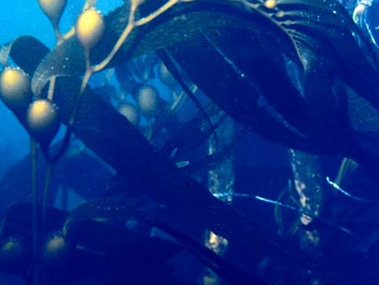
Close-up of a kelp forest. The saclike structures are air bladders that buoy the leaves toward the sea surface to absorb the sun's energy. Courtesy of NOAA Photo Library. Download larger version (jpg, 45 KB).
1869 (Self-contained Underwater Breathing Apparatus)
The Rouquayrol Diving Apparatus
In Jules Verne's science fiction masterpiece, Twenty Thousand Leagues Under the Sea, the following exchange took place between Captain Nemo of the Nautilus and his unwilling scientific hostage, Professor Aronnax. In this exchange, Captain Nemo describes how people could in fact live under the sea and move about freely. He gives an accurate description of the Rouquayrol Apparatus, a working aqualung device that, in fact, was an existing instrument devised by the mining engineer Benoit Rouquayrol in 1865 for use in flooded mines, and modified by his colleague Auguste Denayrouze for use by the French Navy in 1865. This apparatus was the first self-contained underwater breathing apparatus (scuba) and was invented and used almost 80 years before the Cousteau-Gagnan regulator. This discussion showed Jules Verne not only to have a fertile imagination, but also to be knowledgeable concerning the scientific advances of his day:
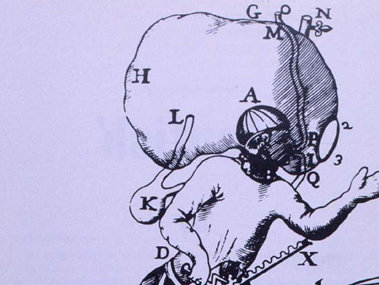
Early concept of the aqualung. Courtesy of NOAA Photo Library. Download larger version (jpg, 92 KB).
Captain Nemo: "You know as well as I do, Professor, that man can live under water, providing he carries with him a sufficient supply of breathable air. In submarine works, the workman, clad in an impervious dress, with his head in a metal helmet, receives air from above by means of forcing pumps and regulators."
Professor Aronnax: "That is a diving apparatus," said I.
Captain Nemo: "Just so, but under these conditions the man is not at liberty; he is attached to the pump which sends him air through an india-rubber tube, and if we were obliged to be thus held to the Nautilus, we could not go far."
Professor Aronnax: "And the means of getting free?" I asked.
Captain Nemo: "It is to use the Rouquayrol apparatus, invented by two of your own countrymen, which I have brought to perfection for my own use, and which will allow you to risk yourself under these new physiological conditions without any organ whatever suffering. It consists of a reservoir of thick iron plates, in which I store the air under a pressure of fifty atmospheres. This reservoir is fixed on the back by means of braces, like a soldier's knapsack. Its upper part forms a box in which the air is kept by means of a bellows, and therefore cannot escape unless at its normal tension. In the Rouquayrol apparatus such as we use, two india rubber pipes leave this box and join a sort of tent which holds the nose and mouth; one is to introduce fresh air, the other to let out the foul, and the tongue closes one or the other according to the wants of the respirator. But I, in encountering great pressures at the bottom of the sea, was obliged to shut my head, like that of a diver in a ball of copper; and it is to this ball of copper that the two pipes, the inspirator and the expirator, open."
In Twenty Thousand Leagues Under the Sea (1869) by Jules Vernes. Courtesy of Project Gutenberg *.
*Project Gutenberg is a major Internet endeavor devoted to the concept that the greatest value created by computers is not computing, but the storage, retrieval, and searching of what is stored in our libraries.
1953-1 (Self-contained Underwater Breathing Apparatus)
Flasks of Compressed Air
"It was then that I met Captain Philippe Tailliez. He was at the time in charge of the Submarine Research Group, the scientific section of the Naval General Staff. And one day, in a little cave near Toulon, he sent me down with some flasks of compressed air on my back and made me bite the rubber tube. I breathed my first draughts of air. The sea opened. I crossed through the looking glass, no longer the ghastly, pallid body with the jerky movements that fish and divers observe with some disgust splashing on the shore."
In The Undersea Adventure (1953) by Philippe Diole. Published by Julian Messner, Inc., New York. p. 10.
1953-2 (Self-contained Underwater Breathing Apparatus)
Men of the Sea
"Perhaps there is, in fact, more to be got out of the sea than food reserves and increased scientific knowledge; an element of reassurance, giving us back confidence and balance, a reminder of true values, a biological wisdom. 'I think,' Robert Gruss has written, 'that diving in self-contained equipment has created a new race: Men of the Sea. They view it in its totality, they bear its weight, and try to learn its secrets. I have never considered diving as an ordinary distraction, or even as a sport. The moment the sea closes over me I feel some great thing is happening. I feel a kind of awe, with really knowing why.'"
In The Undersea Adventure (1953) by Philippe Diole. Published by Julian Messner, Inc., New York. pp. 235-236.
1934-1 (Undersea Vehicles)
How Did It Feel
"I sat crouched with mouth and nose wrapped in a handkerchief, and my forehead pressed close to the cold glass - that transparent bit of old earth which so sturdily held back nine tons of water from my face. There came to me at that instant a tremendous wave of emotion, a real appreciation of what was momentarily almost superhuman, cosmic, of the whole situation; our barge slowly rolling high overhead in the blazing sunlight, like the merest chip in the midst of ocean, the long cobweb of cable leading down though the spectrum to our lonely sphere, where, sealed tight, abyssal darkness as we dangled in mid-water, isolated as a lost planet in outer space. Here, under a pressure which, if loosened, in a fraction of a second would make amorphous tissue of our bodies, breathing our own home-made atmosphere, sending a few comforting words chasing up and down a string of hose - here I was privileged to peer out and actually see the creatures which had evolved in the blackness of a blue midnight which, since the ocean was born, had known no following day; here I was privileged to sit and try to crystallize what I observed through inadequate eyes and interpret with a mind wholly unequal to the task. To the ever-recurring question, 'How did it feel?', etc., I can only quote the words of Herbert Spencer, I felt like 'an infinitesimal atom floating in illimitable space.' No wonder my sole written contribution to science and literature at the time was 'writing at a depth of a quarter of a mile. A luminous fish is outside the window.'"
In Half Mile Down (1934) by William Beebe. Published by Cadmus Books, E. M. Hale and Company, Chicago. pp. 134-135.

Captain Nemo observing a giant octopus from the viewing port of the submarine Nautilus, in Jules Verne's 20,000 Leagues under the Sea. Courtesy of NOAA Photo Library. Download larger version (jpg, 153 KB).
1934-2 (Undersea Vehicles)
Beyond Sunlight
"At 1650 feet I recorded it as being as black as Hades. I was running out of reasonable similes. A school of brilliantly illuminated lanternfish with pale green lights swam past within three feet of my window, their lights being exceedingly bright."
"A little after three o'clock, when we reached 1700 feet, I hung there for a time and made as thorough a survey as possible. The most concentrated gazing showed no hint of blue left. All outside was black, black, black, and none of my instruments revealed the faintest glimmer to my eye. I had now attained one of the chief objects of this whole dive, namely to get below the level of humanly visual light. I was beyond sunlight as far as the human eye could tell, and from here down, for two billion years there had been no day or night, no summer or winter, no passing of time until we came to record it. From here on, even if I went down six miles, to the bottom of the Bartlett Deep, I would experience only differences in degree, not of kind. I could now prove without doubt whether continued observations from a window such as this would yield valuable scientific observations, or whether the attainment of these depths must be considered in the light of merely a stunt, breaking former records."
In Half Mile Down (1934) by William Beebe. Published by Cadmus Books, E. M. Hale and Company, Chicago. pp. 164-165.
1934-3 (Undersea Vehicles)
Man's Recent Period of Strutting in Perspective
"While still near the lowest limit of our dive the thought flashed across my mind of the reality of the old idea of elements - fire, water, earth, and air. They persist as a mental concept, no matter how our physicists and chemists continue to discover new elements, to dismember atoms, and to recognize such invisible phenomena as neutrons. I have seen and felt the heat of molten, blazing stone gushing out of the heart of our Earth; I have climbed three and a half miles up in the Himalayas and floated in a plane still higher in the air, but nowhere have I felt so completely isolated as in this bathysphere, in the blackness of ocean's depths. I realized the unchanging age of my surroundings; we seemed like unborn embryos with unnumbered geological epochs to come before we should emerge to play our little parts in the unimportant shifts and changes of a few moments in human history. Man's recent period of strutting upon the surface of the earth would have to be multiplied half a million times to equal the duration of existence of this old ocean."
In Half Mile Down (1934) by William Beebe. Published by Cadmus Books, E. M. Hale and Company, Chicago. pp. 173-174.
1934-4 (Undersea Vehicles)
These Hidden Multitudes
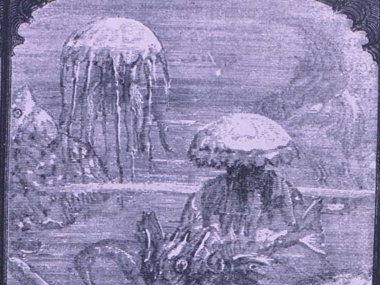
Observing jellyfish from the viewing port of the submarine Nautilus, in Jules Verne's 20,000 Leagues under the Sea. Courtesy of NOAA Photo Library. Download larger version (jpg, 145 KB).
"As I looked out over the tossing ocean and then at the sinking sun, and realized what I had been permitted to see, almost half a mile below the surface, I knew that I should never again look upon the stars without remembering their active, living counterparts swimming about in that terrific pressure. It leaves the mind in a maze of wonder - to think of having seen these hidden multitudes, many most delicate and fragile, moving swiftly on their missions in life - avoiding their enemies, searching for food and finding mates; and all amid this black, ice-cold water with nearly a half-ton of weight crushing down upon every square inch. The recital of such facts as the pressure of fourteen tons of water on the surface of the window out of which I had been looking, or that the whole bathysphere was resisting a weight of over five thousand tons - these probably mean much to anyone who must think only with his imagination of this strange world. When once it has been seen, it will remain forever the most vivid memory in life, solely because of its cosmic chill and isolation, the eternal and absolute darkness and the indescribable beauty of its inhabitants."
In Half Mile Down (1934) by William Beebe. Published by Cadmus Books, E. M. Hale and Company, Chicago. p. 175.
1934-5 (Undersea Vehicles)
A Comparable Place
"... the only other place comparable to these marvelous nether regions, must surely be naked space itself, out far beyond atmosphere, between the stars, where sunlight has no grip upon the dust and rubbish of planetary air, where the blackness of space, the shining planets, comets, suns, and stars must really be closely akin to the world of life as it appears to the eyes of an awed human being, in the open ocean, one half mile down."
In Half Mile Down (1934) by William Beebe. Published by Cadmus Books, E. M. Hale and Company, Chicago. p. 225.
1954 (Undersea Vehicles)
A Blind, Clumsy, Limping Creature
On February 15, 1954, two brave Frenchmen descended to a depth of 13,287 feet in a self-propelled bathyscaphe dubbed F.N.R.S.3. This marked the first time that men would visit the bottom of the sea in abyssal depths and return to tell about it. These brave men, Lt. Commander George S. Houot and Lt. Pierre Henri Willm of the French Navy, braved the unknown to enter a realm that no man had ever seen. They made this descent about 120 miles southwest of Dakar, Senegal, in the tropical north Atlantic Ocean. On reflecting on this accomplishment, Houot spoke words that are as true today as they were on that February day nearly 50 years ago:
"The starting point has been passed. The true scientific researches are about to begin. Sensational results cannot be expected immediately. A committee has been formed to decide how the bathyscaphe is to be used. It includes French and Belgian scientists as well as representatives of the French Navy. The immensity of the domain to be explored and the diversity of the problems to be studied confound the mind. The main lines of research to be followed will make themselves plain as investigation proceeds."
"We are entering on the last stage of man's march toward a knowledge of the surface of the globe. The battle that remains to be fought will be long and hard. Despite the progress of science, the sea remains a hostile element, particularly so at the frontier between the water and the atmosphere. The tool has been created; but let there be no mistake - and Willm and I have no illusions on this point - the F.N.R.S.3 is only a prototype, a blind, clumsy, limping creature. But thanks to her, better machines will be built, aboard which men will go still farther. As it is, she has opened a door that will never be closed again. She is going into service. She will work in the 13,500-foot deeps that she has conquered."
In 2000 Fathoms Down (1955) by Georges Houot and Pierre Willm . p. 182. Translated by Michael Bullock. E. P. Dutton and Company, Inc.
1969 (Undersea Vehicles)
Fish
Towed instrument packages are often referred to as "FISH." Many users of FISH feel that the term probably originated strictly as a descriptive term for a submerged vehicle that is towed through the water with some similarity to finny creatures with gills. However, the first noted use of the term was in the 1942 Hydrographic Manual of the United States Coast and Geodetic Survey. The 808 Fathometer Transducer which was secured from the side of a small vessel was referred to as a "fish." Over 20 years later, Dr. Fred Spiess of the Scripps Institution of Oceanography and originator of the Deep Tow System, coined the acronym "FISH" to describe the torpedo-shaped instrument package that housed the electronics components associated with the system. In a conversation with a science writer, Dr. Spiess defined the term FISH as "Fully Instrumented Submersible Housing." The term FISH has continued in use as a common term to refer to many types of towed instrument packages.
In The New World of the Oceans (1969) by Daniel Behrman. Published by Little, Brown and Company. p. 114.
For thousands of years, our observations of the sea were confined to what they could observe from the surface of the sea or from the seashore. A few intrepid divers risked their lives by plunging into the sea and holding their breath as long as humanly possible, or by working in enclosed caissons while engaged in submarine construction or salvage operations. For the most part, these early excursions into the undersea world had only immediately practical objectives - the search for sustenance or sunken treasure, work on construction projects, or attempts to gain military advantage. With the exception of a few classical observations, the scientific study of the sea from within is a relatively recent phenomenon.

Hard hat diver capturing his views of the wonders of the deep. (Courtesy of NOAA Photo Library.) Download image (jpg, 106 KB).
People began their study of the sea by peering into the waters from vessels or by walking along the seashore. They progressed to free diving, then helmet diving, and finally to the use of SCUBA, which stands for self-contained breathing apparatus. Crushing pressure constrained the unprotected diver to the first few hundred feet of the water column; to overcome the limitations imposed by the environment, the first vehicles to carry scientific observers into the abyss for scientific observation were constructed less than 75 years ago. Today, many scientific diving vehicles routinely carry scientists into the sea to observe marine life, study marine geological processes, and conduct physical oceanographic observations. The following quotations help track some of the milestones and observations made along this journey into the abyss.